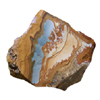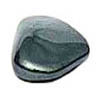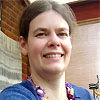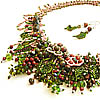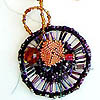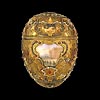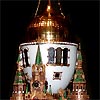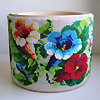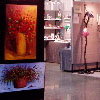March, 2010

Happy blossom time!How can you not love spring - birds singing, flowers blooming, the rest of snow finally melting? Do you have any fun plans for a break? Not yet? So, read MyLovelyBeads.com newsletter!
March gemstones
Contact us with any questions at
info@mylovelybeads.com.
Fashion Colorworks 2010 Featured artist - Lynn Davy Faberge Easter eggs Bead artwork by Yulia Kapustina Step by step - Easter critters April upcoming events Best regards,
MyLovelyBeads.com Team |
March gemstonesThe original birthstones for March are aquamarine and bloodstone. There is another couple of gems some believe they are March stones: jasper and hematite. Jasper is an opaque form of chalcedony, usually red, yellow, brown or green in color. Blue is rare. This mineral breaks with a smooth surface, and is used for ornamentation or as a gemstone. The primary sources of jasper are Russia, Egypt, Germany, Madagascar, Mexico, USA (Oregon, Idaho, Utah, Wyoming, Washington). Green jasper was used to make bow drills in Mehrgarh between 4th-5th millennium BC. Jasper is known to have been a favorite gem in the ancient world; its name can be traced back in Hebrew, Assyrian, Persian, Greek and Latin. On Minoan Crete within present day Greece jasper was carved to produce seals circa 1800 BC based upon archaeological recoveries at the palace of Knossos. Hematite is a mineral, colored black to steel or silver-gray, brown to reddish brown, or red. It is mined as the main ore of iron. While the forms of hematite vary, they all have a rust-red streak. Hematite is harder than pure iron, but much more brittle. Good specimens of hematite come from England, Mexico, Brazil, Australia, United States and Canada. The red chalk winning of this mineral was one of the earliest in history of mankind. The powdery mineral was first used 164,000 years ago by the Pinnacle-Point man obviously for social differentiation. Hematite residues are also found in old graveyards from 80,000 years ago. Near Rydno in Poland and Lovas in Hungary, Paleolithic red chalk mines have been found that are from 5000 BC, belonging to the Linear Pottery culture at the Upper Rhine. Hematite's popularity in jewelry was at its highest in Europe during the Victorian era, and has since seen a strong resurgence in North America, especially in the western United States. It is also used in art such as intaglio engraved gems. |
|
Fashion Colorworks 2010So, you can submit your entries for the Fashion Colorworks 2010 Beading Contest! As one of the contest jurors, Kerrie Slade, said, "Now, there are lots of good reasons to have a go at this contest, not only is it a great personal challenge to work in set color combinations, but it's free to enter, it's open to international entrants, judging is from photos only (so you don't have to worry about packing and posting your creation) and there are prizes to be won - how many beading contests can say all of that?" We are looking forward to seeing your amazing beaded objects at the contest! |
|
Featured artist - Lynn DavyWhat can be harder than to create an amazing piece of beaded jewelry? Yes, you're right, to create the ugliest beaded item! Our guest today is Lynn Davy, the winner of The Ugly Necklace 2009 Contest. Lynn says, "I started playing with seed beads at the age of about 10 (i.e. mid-1970s) and have never really stopped. My beading career began by accident: my mother had a women's magazine with a free self-assembly plastic bead loom on the front (it was blue) and we spent ages tracking down the seed beads to go with it. They weren't widely available back then and all we could find was four little packs of Czech seeds: white, green, orange, and dark blue (I still have some of them). By the time I'd made my first bracelet I was hooked! Next birthday brought a more sturdy wire loom and a book on Native American beadweaving, I learned daisy chain and netting and started experimenting, and it all just carried on from there... ...Seed beads are still my first choice of material, but these days I also use lots of handmade lampwork art glass, freshwater pearls, copper findings, crystals, turquoise, vintage buttons, found objects... but generally not all in the same piece! I have a dozen or more UFOs on my desk at any one time as I always find starting a piece easier than finishing it. Every "major" thing I make seems to go through a crisis about half way through where I absolutely hate it; 9 times out of 10 if I can force myself to work through this point it turns out fine in the end, though! ...In 2009 I was fortunate enough to win prizes in four beading competitions, although oddly enough only one of these was a seed bead piece! I entered the Step by Step Beads "Gemstone Challenge" (for stringing and wirework using four different gemstones) mainly because I'd been complaining bitterly that previous contests were only open to US/Canadian residents, but this one was international and so I felt I should put my beadwork where my mouth was! ...Where do I go from here? Well, I plan to continue publishing projects and designing kits and tutorials, and would like to do more teaching (it's hard work but I just love it). I would really like to bring my work up to the next level now, and be placed in one of the big juried US shows such as Bead Dreams. One of these years I'd love to write a book but that would mean putting everything else on hold and at the moment there are so many other avenues to explore! I've come a long way over the past few years, and traveled in some unexpected directions, so I'm looking forward to what my beady future holds."
Gallery on MyLovelyBeads.com
|
|
Faberge Easter eggsThe egg was a symbol of the rebirth of the earth in Pagan celebrations of spring and was adopted by early Christians as a symbol of the rebirth. The egg is widely used as a symbol of the start of new life, just as new life emerges from an egg when the chick hatches out. The ancient Persians painted eggs for Nowrooz, their New Year celebration, which falls on the Spring equinox. At the Jewish Passover Seder, a hard-boiled egg dipped in salt water symbolizes the Passover sacrifice offered at the Temple in Jerusalem. The pre-Christian Saxons had a spring goddess called Eostre, whose feast was held on the Vernal Equinox, around 21 March. Her animal was the spring hare. Some believe that Eostre was associated with eggs and hares, and the egg symbolized the rebirth of the land in spring. Easter eggs are specially decorated eggs given to celebrate the Easter holiday or springtime. For Orthodox Christians, the Easter egg is much more than a celebration of the ending of the fast, it is a declaration of the Resurrection of Jesus. Traditionally, Orthodox Easter eggs are dyed red to represent the blood of Christ, shed on the Cross, and the hard shell of the egg symbolized the sealed Tomb of Christ - the cracking of which symbolized his resurrection from the dead. Easter eggs are a widely popular symbol of new life in Russia, Romania, Poland and other Slavic countries' folk traditions. A batik (wax resist) process is used to create intricate, brilliantly-colored eggs; there are any other decorating techniques and numerous traditions of giving them as a token of friendship, love or good wishes. The celebrated Faberge workshops created exquisite jeweled Easter eggs for the Russian Imperial Court. Carl Faberge and his goldsmiths designed and constructed the first egg in 1885. It was commissioned by Czar Alexander III of Russia as an Easter surprise for his wife Maria Fyodorovna. On the outside it looked like a simple egg of white enameled gold, but it opened up to reveal a golden yolk. The yolk itself had a golden hen inside it, which in turn had a tiny crown with a ruby hanging inside, reminiscent of the matryoshka nesting dolls. Empress Maria was so delighted by this gift that Alexander appointed Faberge a "Court Supplier" and commissioned an Easter gift each year thereafter, stipulating only that it be unique and contain a surprise. His son, Nicholas II of Russia continued the tradition, annually presenting an egg each spring to his wife Alexandra Fyodorovna as well as his then-widowed mother. Sixty nine jeweled eggs were made by Peter Carl Faberge and his assistants between 1885 and 1917, they were produced almost every year. Once an initial design was approved, the work was carried out by an entire team of artisans under Peter Carl Faberge, among them Michael Perkhin, Henrik Wigstrom and Erik August Kollin. The eggs are made of precious metals or hard stones decorated with combinations of enamel and gem stones. Most of these creations themselves contained hidden surprises such as clock-work birds, or miniature ships. The term "Faberge egg" has become a synonym of luxury and the eggs are regarded as masterpieces of the jeweler's art. They are not edible. |
|
Bead artwork by Yulia Kapustina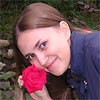
Another artist we want to feature today is Yulia Kapustina. Born in Crimea, she lives in Saint Petersburg now. Yulia had two passions in her childhood - history and foreign languages, but when choosing where to study she decided to go to the Faculty of Oriental Languages of the Leningrad State University, and successfully graduated from it. Each bead artist has its own way in beadart. Yulia's interest in history with the classical humanitarian education, and in crafts has led her to learning antique needlework and bead crocheting techniques. Yulia visits any flea markets, antique stores, museums, and exhibitions looking for old beads, patterns, and books and magazines with articles on beadwork and bead history. Yulia reads a lot of special catalogs and books on beadwork; she is not only learning history of beads, but also writing articles on that, and collecting bead artifacts. Another her passion is creating replicas of old beadworks. She designs purses, belts, boxes and some other accessories. Her intricate work inspired by antique beadart has exhibited many times and it always attracts public attention; Yulia is a winner of many bead contests. Yulia says, that she has dreams: to learn an antique bead technique "sable" almost forgotten; to see amazing bead pieces pulled out from museum storerooms, to open a bead history society where bead amateurs will be able to gather around a table and talk about beads. Yulia dreams to continue learning old beadart and to apply old techniques to the modern beadworks. Yulia, let your dreams come true!
Gallery on MyLovelyBeads.com
|
|
Step by step - Easter critters
There are many decorating techniques and folk traditions to create symbols of new life - Easter eggs, rabbits, birds, hens, etc. A small tutorial by Victoria Katamashvili is on off-loom beadweaving of Easter critters:
How to make Easter critters
|
|
April upcoming events
April 22-25, 2010 Show - The annual Smithsonian Craft Show is a juried exhibition and sale of contemporary American crafts. Three jurors who are experts in the field and newly selected each year choose 120 artists from a large pool of applicants. |
|
Note
If you don't see the newsletter properly formatted please click here:
March Issue
|
© 2010 MyLovelyBeads.com All Rights Reserved.
If you do not want receive our newsletter and you wish to remove your email address from our mailing list, please click the following link to unsubscribe.



